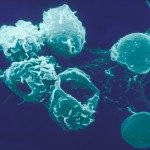Lien vers Pubmed [PMID] – 14627658
J. Neurosci. 2003 Nov;23(33):10724-31
Finding ways to enhance remyelination is a major challenge in treating demyelinating diseases. Recent studies have suggested that circulating bone marrow cells can home in brain and transdifferentiate into neural cells. To ask whether hematopoietic precursors can form myelinating cells, we investigated the neuropoietic potential of embryonic precursors sorted from the mouse aorta-gonads-mesonephros (AGM) region. This cell fraction is capable of long-term hematopoietic reconstitution and generates colonies containing multipotential precursors and lymphoid or erythro-myeloid progenies. When cultured in hematopoietic growth conditions, a fraction of CD45-positive AGM cells coexpress neural markers such as nestin, the polysialylated form of neural cell adhesion molecule, the betaIII tubulin isoform, and glial fibrillary acidic protein. However, when hematopoietic precursors containing green fluorescent protein were cocultured with embryonic striatal precursors into neurospheres, they maintained their hematopoietic phenotype without undergoing differentiation into neurons, astrocytes, or oligodendrocytes. After intraventricular grafting, hematopoietic precursors integrated into the brain of wild-type or hypomyelinated newborn shiverer mice and gave rise to microglia but not neurons or glia. In contrast, when wild-type embryonic striatal neurospheres were grafted in shiverer, they formed numerous myelin internode patches. Even when neural and hematopoietic precursors were grafted together into shiverer mice, only neural precursors generated myelin-forming cells and synthesized myelin. Thus, embryonic neurospheres have myelin repair properties not shown by embryonic hematopoietic precursors. This suggests that the use of multipotential neural precursors to generate myelin-forming cells remains one of the most promising avenues toward remyelination therapies.

